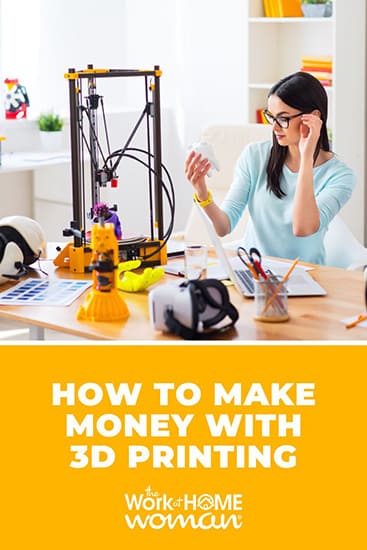If you have an interest in 3D printing, you can turn your interest into cash. Here are the top ways to make money with 3D printing.
3D printers are becoming one of the most exciting and talked-about technologies in the world, and it’s easy to see why! These amazing machines can create almost anything, from detailed models and artwork to functional parts and products.
But what exactly is this piece of hardware, and how does it work? In a nutshell, 3D printers build items by fusing layers of filament plastics or composite materials. This process is controlled by a computer file that contains instructions for the printer.
The file is created using special 3D modeling software, which allows you to design or download models from the internet. With a 3D printer, you can turn your ideas into reality in just a few hours.

And you can use them to start a small business or side hustle since most people don’t own a 3D printer or know how to use one. That’s why a 3D printing business can be very lucrative, given all the ways to use this machine to earn cash.
Here are some of the most popular ways to make money with your 3D printing prowess.
1. Custom 3D Print-on-Demand Service
A printing service involves taking custom orders from customers and printing the requested items for them.
With a print-on-demand business model, you only print items as you receive orders. Since there’s no need to keep a stock of products, it makes for a very flexible and scalable business! You can start small and grow your business as you receive more orders.
It’s a great business model if you enjoy designing different types of 3D prints based on the customer’s needs. For example, customers may request specific things, such as:
- Prototypes for new products
- Custom home decor
- Crafts for school projects
- Custom gifts
Keep in mind that for this business model, you may need more than one type of filament and device to create a wider range of objects. For example, fused deposition modeling machines (or FDM printers) are best for manufacturing low-cost prototypes and bigger, less complex items. However, stereolithography (SLA) printers use a resin that is better for detailed items, molds, and functional parts.
Start by creating a portfolio that showcases your expertise in printing 3D models. Then, set up a website or online shop and start marketing your service through networking and social media platforms like Twitter, Facebook, TikTok, and Instagram.
You can also register your business on 3D printing marketplace websites like Shapeways, Hubs.com, Fiverr, and Treatstock.
2. Create and Sell Your Own Products
If you want to specialize in specific types of 3D printed products, you can create your unique products in advance and sell them online when you create a store on marketplace websites like Etsy or Shapeways.
Some popular items include:
- Architecture models
- Home decor – vases, furniture knobs, unique pieces
- Organization items – jewelry holders, etc.
- Jewelry
- Home office supplies
- Glasses frames
- Kitchen tools
- Toys
- Electronics accessories – phone cases, smart watch bands, etc.
- Hobby supplies – molds, etc.
- D&D miniatures and figurines
Jewelry is a popular option, especially if you create and sell customized pieces with designs or logos on them. A quick search on Etsy will show you how popular this area of unique and handmade goods is becoming.
You can design items from scratch using 3D design software or sell others’ designs (if the copyright license allows it).
Where to Sell Your Wares
One of the best platforms to sell 3D printed products is Etsy, which offers a wide range of tools and resources to help you launch your business.
Another option is to sell your products on Amazon Handmade, which also has a vast customer base and numerous fulfillment centers that can take care of all your inventory, packaging, and shipping.
When listing your products, it’s essential to provide potential buyers with as much information as possible. This includes high-resolution photos of your product, a detailed description, pricing information, and shipping details. It’s also important to set up return policies and shipping times that are reasonable for your potential customers.
While online marketplaces like Etsy and Amazon can give you a leg up via access to their large customer base, marketing will still need to be a big part of your business strategy if you’re going to find long-term success.
Social media platforms are a particularly powerful method of advertising, especially TikTok and Instagram, where you can use videos and visuals to promote your products.
Publish short TikToks and Reels showing how you make and use your products. Remember that consistency is key to building a brand and fan base on social media!
Another excellent way to market your products is through influencer marketing. You can identify relevant social media influencers with a large following in your target market and send them free samples of your product in exchange for them promoting your product to their audience.
This can be a great way to get your 3D-printed products in front of a large number of potential customers.
If you gain a large enough following, you can also consider selling your items through your own online store or Shopify, where you can save on overall fees.
3. Sell Your 3D Printer Design Files
If you have an eye for design and a knack for perfecting your designs, you can sell your design files to other 3D printer owners who are looking for designs and are willing to pay for them.
What kind of designs are people buying? The most popular categories are:
- Jewelry
- Miniatures and models
- Game pieces
- VR/AR
- Gaming
- Cosplay items
- Tools
- Spare parts
This is similar to how people sell their Cricut design files to others. Although people are just starting to sell these on Etsy and eBay, there are other sites specifically for 3D printing and design.
These marketplaces could be good options for selling your 3D printer design files.
- CGtrader – Create your 3D models and keep 70-80% of the sale price.
- Pinshape – You choose a price for each design. Pinshape will add 30% on top of that to create the final customer price.
- Cults3D – Price your designs yourself and keep 80% of the sale price.
- MyMiniFactory – Pay $24.99 each month to have a storefront and keep 92% of all of your sales.
4. Offer 3D Printing Education
There are lots of hobbyists who want to learn how to use a 3D printer but have no idea where to start. You can make a lot of money as an online content creator and educator by showing other people how to design and print 3D items.
Here are some of the best ways to monetize this niche:
3D Printing Blog
Starting a blog is still a great way to make money in 2023, but you need to have a strategy to succeed. The key is consistently publishing blog posts that are helpful to the reader and relevant to 3D printing.
Learning SEO is paramount if you want your blog posts to rank on Google. You can also drive traffic to your blog by guest posting on other blogs in your niche and using social media platforms to share your content.
Once you get enough traffic to your blog, you can monetize with ads through Google Adsense or ad networks like Mediavine, Monumetric, or Raptive.
Another great way to monetize your blog is through affiliate marketing. This is where you partner with products or services related to 3D printing and place affiliate links to their products or services in your content. Then, when someone purchases a product through your link, you get a commission!
For example, if you become an Amazon Associate, you can make a blog post about the best 3D printer tool kits and use your affiliate links to link out to your favorite products on Amazon.
YouTube Channel
YouTube is the second-most powerful search engine after Google and is the number one place people go to learn new things visually.
You can quickly build a following if you consistently publish video tutorials on designing and printing 3D items.
It typically takes several months to grow a YouTube channel, but once you reach 1,000 subscribers and 4,000 hours of watch time, you can apply to be part of the YouTube Partner program, which enables you to make money through ads and other perks like “Supers” (which are essentially like tips), and memberships.
This monetization idea can scale well and make good money if you enjoy creating videos. For example, check out Uncle Jessy’s YouTube channel, which has more than 467K subscribers (at publishing) and likely earns 6-figures.
Repair and Maintenance Instruction
As more and more people begin to use 3D printers, they will – at some point – need to deal with maintenance and repair issues. If these handy skills are in your wheelhouse, they offer an in-demand way to make money with 3D printing.
Film videos or create blog content (or both) that helps other printer owners troubleshoot problems and repair their machines.
Once you become established and start to build a following by showing people how to do repairs, you can expand your reach (and your income) by forming affiliate partnerships or selling physical products you create.
3D Printing Course
If you want to make a more passive income from 3D printing, creating an online course showing beginners how to use a 3D printer is a fantastic option. The major benefit to course creation is that after you create the course content, you can just sell it over and over without any additional work!
You can host your course on several platforms like Teachable, Udemy, or Skillshare.
The key to success with online courses is to create high-quality content that people will find valuable. This means including lots of helpful information, step-by-step instructions, and visuals to help people understand the concepts you’re teaching.
Online courses are most successful when you already have a strong online presence through your blog or social media channels.
Write a Book on 3D Printing
If you have expertise in this area, you can write and sell a book on Amazon by taking advantage of the platform’s self-publishing abilities.
This is a great way to earn recurring passive income while sharing your skills, experience, and ideas with the world.
Promoting your book through social media channels will help drive sales so you earn more money with your 3D printing knowledge.
Consultation Services
As an expert in 3D printing, you can make a lot of money by offering consulting services to businesses or people who need help with their 3D printing projects.
For example, you could offer services like 3D print file optimization, design consulting, or material selection advice. You can find clients through networking, social media, or freelancer platforms like Clarity.fm, Upwork, Fiverr, or JustAnswer and earn $60+ an hour to answer questions.

The Costs of Starting a 3D Printing Business
It’s worth noting that some significant startup costs are involved in starting this kind of business. 3D printers and filaments can be expensive, and you may also need to invest in some software. Here is what you need to know before starting.
How Much Does a 3D Printer Cost?
Depending on the type and size, there is a wide range of prices for 3D printers. The cheaper end is around $200, which is suitable for hobbyists. However, professionals use high-quality printers ranging from $2,500 to $10,000+.
Another option is to rent a 3D printer; companies like Airwolf3D rent out printers starting at $650 per month.
How Much Does Filament Cost?
Filament for FDM printers can vary in cost anywhere from $20 to $120 per kilogram, depending on the material. Entry-level resins for SLA printers typically start at $50 per liter, with professional resins costing up to $400.
What Does 3D Printing Software Cost?
Some printing software, such as Ultimaker Cura and Tinkercad, is free and may do the job depending on the items you are printing. However, they lack the in-depth features and speed you may need for certain business endeavors.
For example, if you offer rapid prototyping services, you will likely need to invest in professional software, like AutoDesk AutoCAD, which costs $245 monthly or $1,975 annually.
Depending on your business model, additional costs, such as shipping, advertising, web hosting, and more, might exist. But these three are the biggest upfront investments you’ll need to make regardless of whether you’re offering services, products, or educational material.
How to Make Money With 3D Printing Wrap-Up
The best way to determine which 3D printing monetization strategy to pursue is to consider what interests you most and where your strengths lie. For example, are you a great designer? Do you want to create specific types of 3D products? Or are you great at teaching?
Whatever path you choose, 3D printing can be much more than a hobby. From Etsy and Amazon to blogging, creating courses, or consulting, countless creatives worldwide are successfully monetizing this fascinating niche! Will you be next?
Check out this post for more creative ways to make money from home!
Originally published September 12, 2022. Content updated November 2023.







Leave a Comment